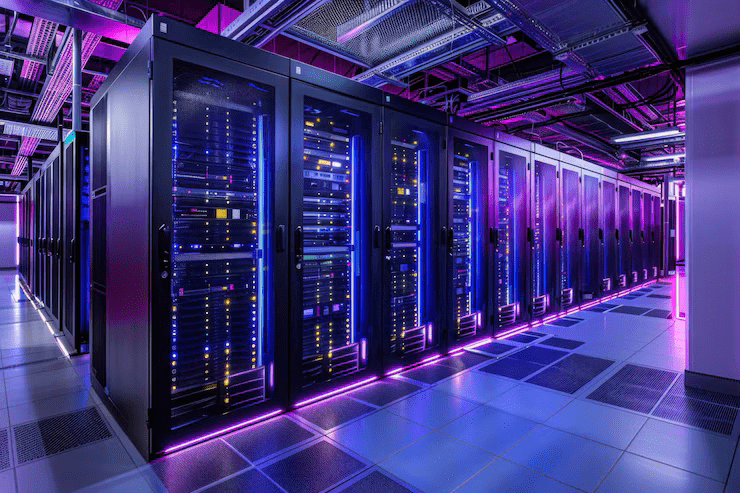Infrastructure security is a fundamental practice of protecting an organization's complete technological framework. It includes approaches and tactics that guarantee the integrity, reliability, and resilience of all the systems and networks founding the backbone of enterprise operations.
The framework of infrastructure security
Network level
The first line of defense is often the firewall in corporate security in IT infrastructure. This establishes a shield between the secure network of your business and the potential threats.
Network infrastructure security intends to protect data as it drives out of and all through the network. Traffic encryption and the management of firewalls are covered in this process.
This level also encapsulates identification and proper authentication systems. Moreover, multi-factor authentications strengthen network defenses, requiring numerous verification processes before access is granted to network assets.
Physical level
This is equally important as network security. It comprises elements like surveillance cameras, fencing, secured doors, and backup generators. Though cybersecurity protects your company’s online assets it certainly does not offer any protection from vandalism, natural disasters, and physical theft. Thus, an all-inclusive physical security strategy covers data recovery protocols perfectly employing offsite backups positioned in several geographic expanses.
Application level
Safeguarding applications encompasses executing measures against possible threats such as SQL injections aiming databases and underpinning applications to endure unauthorized intercessions. The preventative measures include confirming regular patching, integrating API authentication and authorization mechanisms, conducting consistent security tests, and executing stringent input authentication.
Edge level
This is important for securing data and devices at distributed locations. The key elements of this type of IT infrastructure security solution are:
- Real-time threat detection: this implements edge-based security tools to detect and mitigate threats at the point of entry to reduce latency and potential risks. For real-time analysis and response machine learning algorithms and artificial intelligence are employed.
- Device authentication: to control access to edge devices, secure device authentication, and authorization protocols are utilized.
To ensure continuous operations in the case of failed devices or disruptions in the network, edge computing architectures are designed with built-in redundancy. This distribution of data processing across multiple edge notes increases resilience and minimizes the single points of failure.
The implementation of data encryption and secure communication channels between the central infrastructure and edge devices protects sensitive information and maintains privacy.
Data level
Data level infrastructure security emphasizes safeguarding the privacy, integrity, and accessibility of data regardless of its state be it at rest, in transit, or vigorously used. Strategies at this level focus on encryption techniques, data masking, access controls, and tokenization to make sure that unauthorized entities do not have access to or can manipulate sensitive data.
Hybrid level
This addresses the added trials of assimilating on-premise and cloud environments. Key features include:
- Network segmentation: this employs segmentation to separate and detach diverse segments of the hybrid cloud infrastructure to lessen the attack surface. Deploying virtual private networks to generate secure communication channels amongst on-premises and cloud environments.
- Compliance and governance: guarantee compliance with applicable regulations and industry ethics for data protection in both on-premises and cloud settings. Launching governance policies and panels to screen and impose security measures constantly.
The value of a vigorous infrastructure security
Logically, what helps reduce the security risks in an IT infrastructure is its ability to defend your organization from monetary losses arising from cybersecurity threats. A robust infrastructure security system makes sure:
Protection against cyber crimes
This encompasses phishing attempts, botnets, ransomware, etc. The users and their sensitive data are protected by secure infrastructure while preserving hardware and software security on the network.
Sustained business continuity
The risk of workflow disruption is significantly reduced by secure infrastructure. Business operations as a result can run smoothly despite potential threats.
Damage control
The extent of damage in the case of a natural disaster or an attack is limited to secured infrastructure. It also ensures minimized damage and quick recovery.
Improved brand damage
Security breaches affect a company's financial stability along with tarnishing its reputation. Cyber security and IT infrastructure protection therefore enhance the trust among customers and the long-term success and solidity of an organization.
Enhanced compliance and legal standing
The risk of penalties and legal repercussions is reduced with a resilient infrastructure as it adheres to numerous legal requirements and regulatory compliances. Regulations and compliance with industry standards also build a level of trust among customers and stakeholders alike, highlighting the organizations' commitment to defending sensitive information.
How to secure your IT infrastructure?
Here we have identified for you some IT infrastructure security policies that an organization must adopt for a comprehensive security strategy.
Security compliance standards
Organizations can maintain a consistent approach to network infrastructure security across all functions and departments if they have clear compliance standards in place. This ensures there are no weak links in the security chain.
There is a need for security procedures, controls and policies to be documented thoroughly. It is also important to make all the employees as well as the IT team aware of these standards.
HIPAA, GDPR, and PCI DSS fall among a set of protocols that certain industries have. These include risk assessment and management practices, so your organization can recognize possible threats and thus address them accordingly.
Encryption of data
The first line of defense includes prioritizing the use of data encryption. This is because this kind of data is not accessible to hackers. For an added layer of infrastructure security, virtual private networks also need to be implemented by technology consultants. This is particularly essential for remote staff that need access to private data. To further enhance the security of remote access points, multifactor authentication in tandem with VPNs is required.
Backup copies
To help maintain security in IT infrastructure, it is essential to regularly create backup copies. These duplicate data, configurations, and applications. The organization is thus able to recover the data that is lost through hardware malfunctions, accidental deletions, and malicious ransomware attacks, thus serving as a safety net.
Business continuity is also ensured with backup copies in cases of system failures as these minimize downtime and allow your organization to maintain their services thus upholding customer trust.
Endpoint security implementation
IT infrastructure security policies also include the protection of all devices that are connected to your network like tablets, laptops, smartphones, and IoT devices. Firewalls, antivirus programs, intrusion detection systems, and endpoint detection and response tools are all part of the endpoint security solutions. All the end-point activities are identified and monitored to block and respond to suspicious actions. Moreover, this also involves the establishment of rules that dictate who has access to the network, from what device, and in what circumstances.
Role-based access enabled
This is another element of IT infrastructure security solution that restricts network access based on individual user roles within the organization. This assigns authorization to specific roles rather than specific users ensuring not only the required personnel have access to certain resources plummeting the probable peril of inadvertent data breaches. The role-based access restricts the number of users who have access to explicit information while streamlining complete user management.
Regular security audits
To identify possible weaknesses IT infrastructure security audit and implementation solutions are conducted so strategies can be developed to mitigate these. These security checks serve as a crucial feature of a robust infrastructure security strategy and offer you a clear picture of your organization's security position. These checks certify compliance with industry regulations and enhance infrastructure security investments.
Strong firewalls and intrusion detection
Firewalls serve as barriers between harmful external networks and trusted internal ones. Based on predefined security policies incoming and outgoing traffic is filtered to allow data packets depending on their destination, source, and type.
Network traffic is continuously monitored by intrusion detection systems as they detect irregularities and patterns that identify a security breach.
The organization can benefit greatly from comprehensive network visibility and real-time threat detection by the integration of IDS and firewalls. This way critical data and assets are also protected as the risks associated with cyber threats are mitigated, therefore enhancing the overall security in IT infrastructure.
The effectiveness of IDS and firewalls, however, is dependent on configuration and correct setup. If the firewall is poorly set then it is likely to pose as much risk as not having one. Regular updates and proper execution are significant to make sure that these systems offer the maximum level of protection against all kinds of threats.
Security awareness training
Educating the employees on how to identify potential threats so they can be addressed properly is imperative. This will enable your company to adopt a culture of security vigilance suggestively dropping the perils of breaches resulting from human error.
Some essential aspects of this training include:
- Employee training to recognize and report phishing attempts
- Guideline for safe Internet practices
- Instruction for managing and storage of sensitive data
- The emphasis on creating strong passwords and regular system updates
Regular monitoring of network traffic
The regular monitoring of network traffic is not only confined to certifying network infrastructure security but also preserving the finest network health and performance. It is a crucial constituent that guarantees both data protection and operational productivity. Monitor network traffic for unusual and suspicious activities. You can detect unauthorized actions and threats in real-time by analyzing the flow of information, thus making sure the infrastructure security is enhanced.
Periodic system testing
This is an essential practice to make sure that a company’s IT system and applications operate as intended and are secure against all kinds of threats. To deal with challenges both current and in the future, there needs to be a systematic evaluation of hardware, software, and network components.
Employing diverse testing methods is also important. This includes functional testing, performance testing, and penetration testing. It is also recommended to implement automated testing tools to increase the efficiency, coverage, and accuracy of the testing procedure. It is also essential to update testing scripts to acclimatize to variations in system features and requirements.
Incident response plan
A clear incident response plan is necessitated for prompt response in the event of an incident. For this, it is imperative to define and classify what creates an incident and set up an incident response team. Launching monitoring mechanisms that will spot anomalies and threats. Recognizing explicit measures that need to be taken to prevent the incident from intensifying is also very important.
The final verdict
So, infrastructure security encapsulates two elements; firstly, it seeks to improve security protocols and the general security bearing of an organization. Secondly, it endeavors to decrease potential interruptions and the ensuing risks like reputational harm, customer attrition, and intensifying compliance-related expenses. Therefore, all organizations need to employ the best practices for security in their IT infrastructure to ensure their company is protected from all threats.







